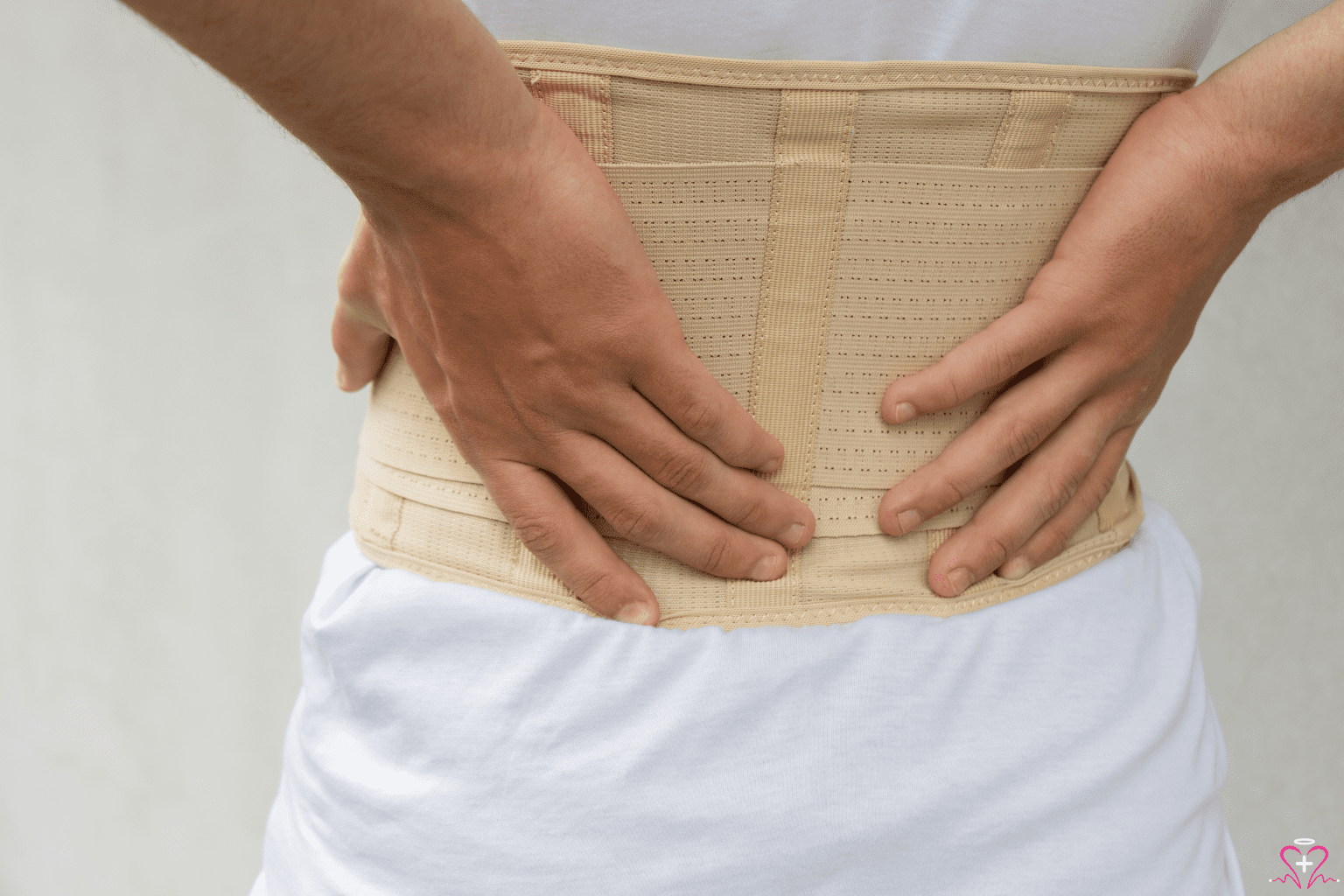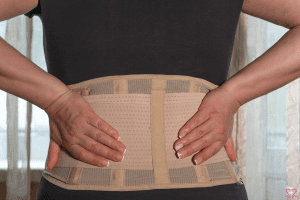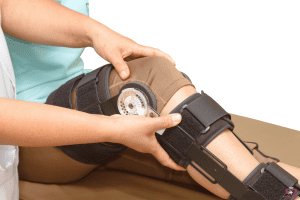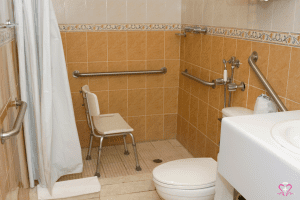Exercises to Strengthen Your Knees
The knee, a complex joint, is pivotal to our mobility. Its strength is crucial for daily activities.
Yet knee pain is a common ailment. It can stem from various conditions and affect people of all ages.
Strengthening exercises can alleviate knee pain. They can also prevent injuries, aiding in post-surgery recovery.
This article delves into exercises for fortifying knees and explores the supportive role of back and knee braces.
Back braces can aid in posture correction and provide relief from conditions like sciatica, lower back pain, and scoliosis.
We will guide you on how to use these braces effectively, discuss their efficacy, and debunk common myths.
This article will be a valuable resource for athletes, healthcare professionals, and anyone experiencing knee or back pain.
The Integral Anatomy of the Knee Joint
The knee joint is a hinge joint connecting the thigh bone (femur) to the shin bone (tibia). It is one of the human body’s largest and most complex joints.
The knee joint also includes the kneecap (patella), which slides in a groove on the end of the femur. Ligaments and tendons connect the bones of the knee joint, while cartilage provides cushioning to absorb shock during movement.
Understanding the anatomy of the knee joint is crucial. It helps us comprehend the impact of knee strength on overall mobility and injury prevention. It also sheds light on the importance of exercises targeting specific knee muscles for optimal joint stability.
Explore Senior Care ServicesThe Correlation Between Knee Strength and Spinal Health
The strength of the knee joint plays a significant role in maintaining spinal health. This is due to the interconnected nature of the musculoskeletal system, where weakness in one area can lead to compensatory changes in another.
Weak knees can contribute to an altered gait or posture, placing additional strain on the spine. Over time, this can lead to back pain and other spinal issues. Therefore, knee strengthening can indirectly contribute to improved spinal health and posture.
Conversely, back pain can also affect the knees. Conditions such as sciatica, where pain radiates down the leg, can lead to knee discomfort. In such cases, using a back brace may provide relief by improving posture and reducing strain on the spine and knees.
Common Knee Afflictions and the Efficacy of Strengthening Exercises
Knee pain is a common complaint among individuals of all ages. It can arise from various conditions, including osteoarthritis, ligament injuries, meniscus tears, and patellofemoral pain syndrome. These conditions can significantly impair mobility and quality of life.
Strengthening exercises are a cornerstone of treatment for many knee conditions. They work by improving the stability of the knee joint, reducing the load on damaged structures, and promoting healing. For instance, exercises targeting the quadriceps and hamstrings can help manage symptoms of osteoarthritis and prevent further joint degeneration.
In addition to managing existing conditions, knee-strengthening exercises can also play a preventive role. By improving muscle strength and joint stability, these exercises can reduce the risk of injuries, particularly in athletes and physically active individuals.
However, it’s important to note that not all exercises are suitable for all conditions. Depending on the specific knee condition, some exercises may need to be modified or avoided altogether; therefore, consulting with a healthcare professional before starting a new exercise regimen for knee strengthening is crucial.
Quadriceps Fortification: A Keystone for Knee Stability
The quadriceps, a group of four muscles at the front of the thigh, play a crucial role in knee stability. They extend the knee and provide support when standing, walking, and running. Strengthening these muscles can, therefore, significantly improve knee function and reduce the risk of injury.
Several exercises can effectively target the quadriceps. These include straight leg raises and wall sits, which can be performed without special equipment. These exercises are particularly beneficial for individuals with knee pain, as they are low-impact and unlikely to exacerbate symptoms.
When performing quadriceps exercises, proper form is important to ensure their effectiveness and prevent injuries. This includes keeping the back straight, engaging the core, and ensuring the knee is properly aligned with the foot.
Exercise 1: Straight Leg Raises
Straight leg raises are a simple yet effective exercise for strengthening the quadriceps. They can be performed lying down, making them suitable for individuals with limited mobility or severe knee pain.
To perform this exercise, lie on your back with one leg bent and the other straight. Slowly lift the straight leg to the height of the bent knee, then lower it back down. Repeat this movement 10-15 times, then switch to the other leg.
Exercise 2: Wall Sits
Wall sits are another excellent exercise for the quadriceps. They also engage the glutes and hamstrings, making them a comprehensive lower-body exercise.
To perform a wall sit, lean against a wall with your feet shoulder-width apart. Slowly slide down the wall until your thighs are parallel to the floor, then hold this position for 10-30 seconds. Repeat this exercise 5-10 times.
Hamstring Strengthening: Essential Exercises for Knee Support
The hamstrings at the back of the thigh are equally crucial for knee stability. These muscles work in tandem with the quadriceps to control knee movement, particularly during activities that involve bending the knee, such as running and jumping. Strengthening the hamstrings can, therefore, help balance the forces acting on the knee and reduce the risk of injury.
Hamstring curls and deadlifts are two practical exercises for strengthening these muscles. Depending on the individual’s fitness level and the severity of their knee pain, these exercises can be performed with or without weights.
Proper form is crucial when performing hamstring exercises to prevent strain and injury. This includes keeping the back straight, engaging the core, and ensuring the knee is properly aligned with the foot.
Exercise 3: Hamstring Curls
Hamstring curls are a simple exercise that can be performed standing or lying down. They specifically target the hamstrings, making them an excellent choice for individuals looking to strengthen these muscles.
Stand upright with your feet hip-width apart to perform a standing hamstring curl. Slowly bend one knee, bringing your heel towards your buttocks. Lower your foot back down and repeat the movement with the other leg. Perform 10-15 repetitions on each leg.
Exercise 4: Deadlifts
Deadlifts are a more advanced exercise that targets the hamstrings,e glutes,s, and lower back. They require a barbell or dumbbell, making them suitable for individuals with access to gym equipment.
To perform a deadlift, stand with your feet hip-width apart and hold the barbell or dumbbells in front of your thighs. Bend at the hips and knees to lower the weights towards the floor, keeping your back straight. Push through your heels to return to the starting position. Perform 10-15 repetitions.
Proprioception and Balance: Exercises for Enhanced Knee Function
Proprioception, the body’s ability to sense its position in space, is crucial for maintaining balance and preventing falls. This sense can be impaired in individuals with knee pain or after a knee injury, leading to instability and an increased risk of re-injury. Therefore, incorporating balance exercises into a knee strengthening program can help to improve proprioception and enhance overall knee function.
Balance exercises can be as simple as standing on one leg or more complex, such as using a balance board or performing yoga poses. These exercises strengthen the muscles around the knee and challenge the nervous system, helping to improve coordination and reaction times.
It’s essential to start with simple balance exercises and gradually increase the difficulty as your balance improves. Always ensure you have something to hold onto for support when starting to prevent falls.
Exercise 5: Balance Exercises
Balance exercises are versatile exercises that can be tailored to suit individuals of all fitness levels. They can be performed anywhere, anytime, and require no special equipment, making them an accessible option for most people.
One simple balance exercise is the single-leg stand. To perform this exercise, stand upright and lift one foot off the ground, balancing on the other leg. Try to maintain this position for as long as possible, aiming for 30 seconds to a minute. Repeat on the other leg. As your balance improves, you can increase the difficulty by closing your eyes or standing on an unstable surface, such as a cushion or balance board.
Low-Impact Exercises for Knee Rehabilitation
For individuals with knee pain or recovering from a knee injury, low-impact exercises can be a safe and effective way to strengthen the knee without causing further damage. These exercises place less stress on the knee joint, reducing the risk of injury and making them a suitable option for those with arthritis or other knee conditions.
Low-impact exercises include activities such as swimming, cycling, and water aerobics. These exercises can help to improve cardiovascular fitness, promote weight loss, and strengthen the muscles around the knee, all of which can contribute to enhanced knee health.
It’s important to start slowly with low-impact exercises and gradually increase the intensity and duration as your knee strength improves. Always listen to your body and stop if you experience any pain.
Exercise 6: Swimming and Water Aerobics
Swimming and water aerobics are excellent low-impact exercises for knee rehabilitation. The buoyancy of the water supports your weight, reducing the load on your knees and allowing you to move more freely without pain.
Swimming and water aerobics can strengthen the muscles around the knee and improve flexibility and endurance. These exercises can be easily modified to suit your fitness level and performed even by those with severe knee pain or limited mobility.
Progressive Resistance Training: Using Bands for Knee Strength
Progressive resistance training is a method of exercise that involves gradually increasing the resistance to continually challenge your muscles. This training can be particularly beneficial for strengthening the knees, as it allows for targeted, controlled movements that can be adjusted to suit your individual needs and abilities.
Resistance bands are a versatile tool for progressive resistance training. They come in various resistance levels, allowing you to start with a lighter band and progress to a heavier one as your strength improves. Resistance band exercises can target both the quadriceps and hamstrings, providing a balanced workout for the knee.
Remember, proper form is important when performing resistance band exercises to avoid injury. Always consult with a healthcare professional or a certified fitness trainer if you’re unsure how to perform these exercises correctly.
Exercise 7: Resistance Band Leg Press
The resistance band leg press is a simple yet effective knee-strengthening exercise. This exercise targets the quadriceps, the large muscle group at the front of the thigh that plays a crucial role in knee stability.
To perform this exercise, you’ll need a resistance band and a sturdy post or furniture to anchor the band. Begin by sitting on the floor with your legs extended in front of you. Loop the resistance band around the soles of your feet and hold the ends in your hands. Bend your knees, pull the band towards you, and slowly extend your legs. Repeat this movement for the desired number of repetitions.
Explore Senior Care ServicesFunctional Exercises for Dynamic Knee Health
Functional exercises are movements that mimic everyday activities or specific sports skills. They are essential for maintaining knee health as they strengthen the muscles and improve balance, coordination, and flexibility. These exercises often involve multiple joints and muscle groups, providing a comprehensive workout.
Step-ups and lunges are two functional exercises that are particularly beneficial for knee strength. They target the quadriceps, hamstrings, and gluteal muscles, which all play a crucial role in knee stability. Moreover, these exercises can be easily modified to suit different fitness levels and performed with or without additional weights.
Remember, as with any exercise, proper form is important to avoid injury. Always consult with a healthcare professional or a certified fitness trainer if you’re unsure how to perform these exercises correctly.
Exercise 8: Step-Ups
Step-ups are a simple yet effective exercise for strengthening the knees. This exercise targets the quadriceps, hamstrings, and gluteal muscles, providing a balanced workout for the knee.
To perform this exercise, you’ll need a sturdy step or platform. Begin by standing in front of the step. Step up onto the step with one foot, followed by the other. Step back down, leading with the same foot. Repeat this movement, alternating the leading foot with each set.
Exercise 9: Lunges
Lunges are another functional exercise that can strengthen the knees. This exercise targets the quadriceps, hamstrings, and gluteal muscles, providing a balanced workout for the knee.
To perform a lunge, begin by standing with your feet hip-width apart. Step forward with one foot and lower your body until your front knee is bent at a 90-degree angle. Your back knee should hover just above the ground. Push back up to the starting position and repeat with the other leg.
The Role of Bracing in Knee and Back Health
Bracing plays a significant role in both knee and back health. It supports the affected area, reduces pain, and aids healing. Braces are often used with physical therapy and exercise to maximize recovery and prevent further injury.
Knee braces are designed to provide stability and support to the knee joint. They are often used after an injury or surgery to immobilize the knee and allow it to heal. They can also provide support during physical activity, reducing the risk of injury.
Back braces, on the other hand, support and stabilize the spine. They can help correct posture, reduce pain, and prevent further injury. Back braces are often used to treat scoliosis and lower back pain.
It’s important to note that while braces can provide support and relief, they are not a substitute for proper exercise and physical therapy. They should be used as part of a comprehensive treatment plan under the guidance of a healthcare professional.
Knee Braces: Types and Indications
Several knee braces are available, each designed for a specific purpose. The most common types include the knee immobilizer brace, the knee hyperextension brace, and the knee brace for support.
The knee immobilizer brace restricts movement and provides stability to the knee after an injury or surgery. It is designed to keep the knee straight so that it can heal.
The knee hyperextension brace prevents the knee from bending backward, a condition known as hyperextension. This type of brace is often used to treat certain knee conditions and injuries.
The knee brace provides additional support to the knee during physical activity. It can help reduce the risk of injury and relieve pain and inflammation.
Back Braces: Supportive Measures for Spinal Alignment
Back braces are designed to support the spine and improve posture. They can be used to treat a variety of conditions, including lower back pain, scoliosis, and spinal fractures.
The back support brace supports the lower back and reduces pain. It can be worn during physical activity to prevent injury and relieve chronic lower back pain.
The posture back brace is designed to correct posture and retrain the muscles. It can help reduce the strain on the spine and prevent further injury.
The TLSO back brace, or thoracolumbosacral orthosis, provides support to the thoracic and lumbar regions of the spine. It is often used to treat spinal fractures and other serious spinal conditions.
Implementing a Knee Strengthening Regimen: Best Practices
Embarking on a knee-strengthening regimen requires careful planning and execution. It is crucial to start slowly and gradually increase the intensity of the exercises. This approach helps prevent injury and allows the body to adapt to the new physical demands.
Proper form is of utmost importance when performing knee exercises. Incorrect form can lead to injury and may not provide the desired strengthening benefits. It is advisable to seek guidance from a physical therapist or a trained professional to ensure the exercises are performed correctly.
In addition to the exercises, it is essential to incorporate rest and recovery into the regimen. Overworking the muscles can lead to fatigue and injury. Therefore, it is recommended to have rest days in between workout days to allow the muscles to recover and grow stronger.
Addressing the Myths: The Effectiveness of Knee and Back Braces
The effectiveness of knee and back braces is an ongoing debate in the medical community. Some argue these devices provide necessary support and stability, while others contend they can lead to muscle atrophy and dependence. It is essential to understand that the effectiveness of braces can vary greatly depending on the individual’s condition, the type of brace used, and how it is used.
For instance, a knee brace can be highly effective in providing support and stability for an individual recovering from knee surgery. However, the same brace may not be as effective for an individual with chronic knee pain due to arthritis. Similarly, a back brace can relieve someone with lower back pain but may not benefit someone with poor posture due to weak core muscles.
In conclusion, knee and back braces can effectively manage specific conditions, but they are not a one-size-fits-all solution. Consulting with a healthcare professional to determine the most appropriate treatment plan is crucial.
Consultation with Healthcare Professionals: A Prerequisite for Brace Usage
Before deciding to use a knee or back brace, it is imperative to consult with a healthcare professional. This is because using these devices should be based on a thorough evaluation of the individual’s condition. A healthcare professional can provide an accurate diagnosis and recommend the most appropriate type of brace.
Moreover, a healthcare professional can adequately guide you on how to use and care for the brace. This includes instructions on how to wear the brace, how long to wear it, and how to clean it. Incorrect brace usage can lead to further complications and may even exacerbate the condition.
In conclusion, while knee and back braces can be beneficial, they should always be used under the guidance of a healthcare professional. Self-diagnosis and self-treatment can lead to adverse outcomes and should be avoided.
Conclusion: Embracing Knee Health as a Lifelong Journey
The journey to knee health is a lifelong commitment. It requires consistent effort in strengthening exercises, maintaining proper posture, and using supportive devices like braces when necessary. It is not a quick fix but a continuous process contributing to overall health and well-being.
Ultimately, the goal is not just alleviating knee pain or correcting posture. It enhances mobility, prevents injuries, and improves quality of life. With the proper knowledge, guidance, and tools, everyone can embark on this journey and reap the benefits of solid and healthy knees.
References and Further Reading
For further reading and more detailed information, consult reputable health and fitness resources, medical journals, and publications from orthopedic associations. Always seek advice from healthcare professionals before starting any new exercise regimen or using supportive braces.










